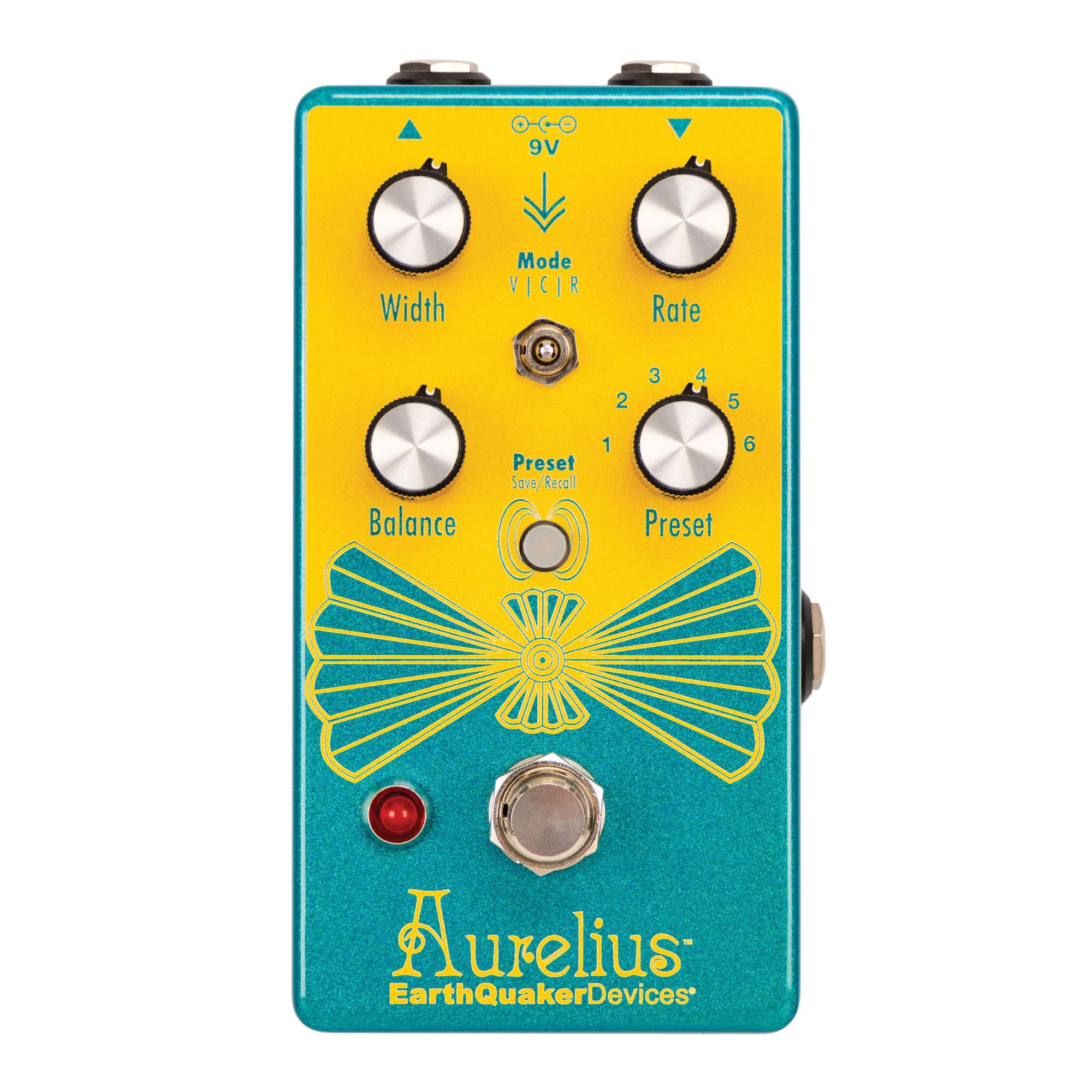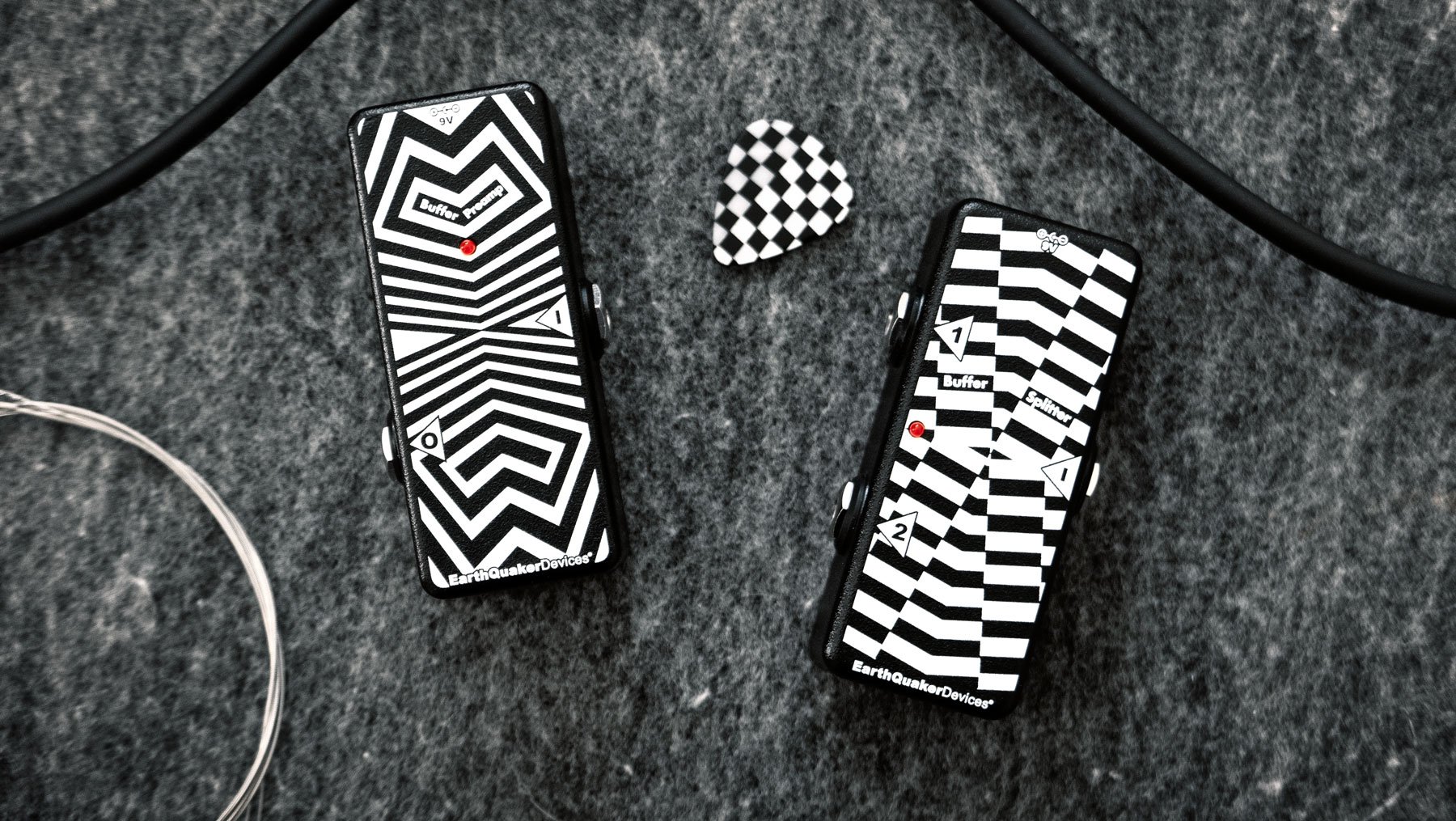How Aurelius Can Help You Sound Like Five Classic Songs
Dan Epstein
Aurelius is a remarkable and really fun pedal, and I’ve spent a good portion of my free time over the last month getting seriously lost in it. The unit’s three modes — Chorus/Vibrato (Mode V), Chorus/Flanger (Mode C) and Rotary Chorus (Mode R) — can unleash all manner of chorus effects from classic to crazy. And when you throw in the ability to save and recall six different presets, as well as the potential to control (or further warp) your sounds with an expression pedal, well … you can perhaps understand why I’ve been so preoccupied as of late.
Don’t let the bells and whistles intimidate you, however. Aurelius is a remarkably easy pedal to use right out of the box, and with just a few tweaks of the controls (Width, Rate and Balance), you’ll be coming up with a wide array of delicious and highly usable textures. Even if you’re not a player who typically uses a lot of chorus, you might be surprised by the many ways Aurelius can lend a little “special sauce” to your sound.
To get you started, here are five classic songs with instantly recognizable chorus sounds, along with the Aurelius settings that will help you replicate them.
Rush — Freewill
Rush guitarist Alex Lifeson initially fell in love with the chorus effect after plugging into a Roland JC 120 during the making of 1977’s A Farewell to Kings. Chorus, along with flanging and delay, quickly became a mainstay of his guitar sound, both onstage and in the studio. “I was always looking for ways to fill things out,” he told this writer back in 2020, “because Geddy [Lee] and Neil [Peart] were such active players… and that was great for me, because it taught me how to explore chordal structure, and how to get the most out of a note in terms of an ensemble.”
From A Farewell to Kings on through 2012’s Clockwork Angels, Lifeson regularly combined ringing open chords with chorus and flange pedals to color the mood of the music and fill out Rush’s sound. “Freewill,” one of the standout songs from their 1980 breakthrough Permanent Waves, is a prime example of this. While Aurelius can’t help you imitate Lifeson’s ridiculously impressive chops, it can help you cop his sound from that track — especially if you’re using a guitar with humbuckers and plugging it into a slightly distorted amp. Just put the pedal in Mode C to give yourself a blend of chorus and flanger; then set the Width at 2 o’clock to bring out the swirl of the effect, set the Rate at 8 o’clock so there’s just the barest hint of regeneration, and crank the Balance to 4 o’clock to really boost the flavor. Dial off a bit of the treble on your guitar to taste, and boom — you’re ready to start sliding those triads up and down the neck in alternating 6/4 and 7/4 time with a little bit of 8/4 thrown in!
Pretenders — Talk of the Town
James Honeyman-Scott only made two albums (and one EP) with the Pretenders before his premature death at the age of 25, but both of those records — 1980’s self-titled debut and 1981’s Pretenders II — remain object lessons in how two wildly different guitarists can forge a unique and unforgettable musical partnership. Honeyman-Scott was a brilliant lead player with a classic rock background (the Allman Brothers and Mott the Hoople were two of his biggest early influences), yet he provided the perfect foil for Chrissie Hynde’s choppy, odd-metered punk-rock rhythm approach, bridging the stylistic gap between them with jangly and melodic chordal work inspired by early Elvis Costello and Nick Lowe records.
Honeyman-Scott’s plangent chords and richly chiming arpeggios were considerably bolstered by his use of chorus and flange pedals. “Talk of the Town,” originally released in the spring of 1980, is a particularly gorgeous showcase for this aspect of this playing, and you can use Aurelius to replicate his ringing sound on it. With the pedal in Mode C, dial the Width and Balance controls to 12 o’clock, set the Rate control at about 1 o’clock, and you’ll have that classic JH-S combination of shimmer with just a touch of “whoosh.” Humbuckers are needed to really match the fullness of his sound, but single coils will definitely put you in the ballpark — just hit the song’s open Am7 with the aforementioned settings and hone it further from there.
Nirvana — Come As You Are
While the late, great Kurt Cobain typically gravitated towards cheap pawn shop axes — and smashed up more than a few of them — that didn’t mean he wasn’t interested in guitar gear, or in the sonic possibilities of effects pedals. Nevermind, Nirvana’s breakthrough 1991 album, was positively awash in chorus effects, and sent a whole generation of budding guitarists scrambling to their local guitar shops in order to try and replicate the wobbling, watery sounds they heard on tracks like “Smells Like Teen Spirit” and “Come As You Are.”
For that “Come As You Are” sound, just put Aurelius in Mode C, set the Width and Rate controls at 3 o’clock, and the Balance at 1 o’clock. For best results, put a little dirt on it — either via your amp’s gain setting or a distortion pedal — and play the main riff on your neck pickup to really get the same warm and round tone as the record. Oh, and be sure to tune your lower E string down to D like Kurt did; otherwise, you’re not gonna be able to reach those low notes!
The La’s — There She Goes
There was a whole lotta janglin’ goin’ on in the mid/late-80s British music scene — The Smiths, The Stone Roses, The Primitives, House of Love, The Wedding Present and even early Primal Scream were among the numerous bands building their sound around ringing guitar chords and shimmering arpeggios. But the most quintessential UK jangle-pop track of the era has to be “There She Goes,” the 1988 single from Scouse strummers The La’s, which remains best-known in its 1990 Steve Lillywhite remix incarnation. The song has been covered numerous times, but it’s hard to improve upon sheer perfection…
In order to make the song’s signature two-string opening riff chime like it does on the record, put Aurelius in Mode V, set the Width at 8 o’clock to keep the pitch modulation sweep nice and tight, set the Rate and Balance controls to 12 o’clock, and play the lick on your bridge pickup through a clean amp. Not only does this setting totally nail the “There She Goes” tone, but it also works nicely with at least half of the first Stone Roses album!
Ringo Starr — It Don’t Come Easy
One of the greatest of the Beatles’ post-breakup solo singles, 1971’s “It Don’t Come Easy” listed only Ringo’s name in the writing credits, but the song clearly had George Harrison’s fingerprints all over it. For one thing, its lyrical themes of peace, devotion and trust were all favorite songwriting topics of the “Quiet Beatle”; but even if the song had just been an instrumental track, the Leslie-fied lead guitar riff that opens and closes it would still bear a notable resemblance to a number of Harrison’s guitar parts from Abbey Road. But hey, that’s just how much of a mensch George was — not only did he give away a surefire hit to his dear friend, but he also allowed him to take full writing credit on it.
Though Harrison used an actual Leslie rotary speaker to get that gloriously swirling “It Don’t Come Easy” sound, you can obtain a remarkably convincing facsimile using Aurelius. Set the pedal to Mode R, then set the Width at 12 o’clock for a nice middle ground between the “woofer” and “horn” frequencies. Dial the Rate down to 9 o’clock to keep the speed of the “rotation” slow, and set the Balance to 11 o’clock to tame the pulsing sub-frequencies. Play the riff on your bridge pickup through a clean amp, and you’ll be forgiven for thinking that maybe it does come easy, after all. (And spoiler alert: With a few slight tweaks, this same setting will help you replicate a lot of late-60s Beatle tones, not to mention Eric Clapton’s ringing guitar refrain on Cream’s “Badge!”)
Dan Epstein is an author, editor, journalist and guitarist based in New York's Hudson Valley. He writes about his latest musical obsessions at Jagged Time Lapse, and songs from his latest musical project The Corinthian Columns can be found at corinthiancolumns.bandcamp.com











